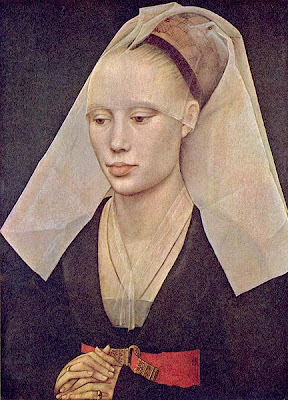 |
| "No, I'm totally not looking down your dress... Why do you ask?" |
This period of history is commonly called the Renaissance. Here is a video about that...
So that's fun. However, this is a class about fashion.
Generally speaking, I'm not all that thrilled about fashion during this century. Sure, all sorts of things were happening but I consider it a "transition" century. The first part of the 1400's looks a lot like the tail end of the 1300's,
 |
| "The black line on my head is the wire keeping my horns on.." |
and the second part looks almost just like everything in the 1500's.
 |
| "Ugh, I'm so tired of this lame pearl rosary.." |
Which is to say, it's pretty much like studying women's fashion in the 1930's.
 |
| Both of these images are from the same decade |
It just isn't anything but what it was and what it will be and it's probaby that way because there was a lot of war.
Yeah, I know that sounds weird. Let's look at some actual facts.
The smock or chemise I think we all understand. It was the underdress which kept sweat and dirt from the heavy outer clothing. One would change your chemise every day (hopefully) but keep wearing the gown because it never touched skin. The kirtle is harder to explain but I think it's best thought of as a precursor to the corset. A large, full-length-dress-sized corset. It was an extra layer (in a cold cruel world) which was laced tight and acted as a foundation garment. Sounds pretty corset-y to me...
 |
| You can't see anything here but gown, an amazing hairstyle, and some terribly disproportiate arms. I love looking at this picture. |
Hats continued to evolve, with the shaved forehead look becoming popular for the fashion victims of this century.
 |
| So.. much.. forehead.. |
The waistlines remained pretty high for most of the century but eventually moved down as the deep v-necks moved into the square necklines which would dominate the next century.
One interesing thing was the beginning of slashing. While the word sounds dramatic, it really just meant cutting parts of the gown (or doublet) to show the rich fabric underneath. (Allegedly, soldiers started this trend when they raided a rich city and mended their torn clothing with bits of fancy silk from the vanquished.) Sometimes this just meant slashing the sleeves of the gown to show the kirtle, but sometimes it also meant cutting a lot of little slashes and making puffs out of the smock beneath.
 |
| I'm showing my kirtle |
 |
| Our chemise is showing... out of our sleeves. |
One thing to remember about this time period is that the only fasteners they had for clothing were laces, buttons, or pins. Sleeves were generally just tied on,
 |
| as you can see here, |
and if they were of good quality, they sometimes got tied on to other dresses.
 |
| which is what is happening here. |
By the end of the century, women were beginning to either have a high square neck or to simply lace up the front of their dresses like this:
 |
| "My gown is blue, my kirtle is black with a fancy red and gold brocade skirt." |
The important thing to remember is that waistlines got lower as the population stabilized.
In menswear, however, an awful thing started. Here's the video.
I do need to make one correction to this video. In it I stated that hose were knit. While that was sometimes true, men's hose was also made out of fabric which had been cut on the bias, thus allowing for the tight fit in a world without elastic or zippers or velcro.
And, that about covers it. One more picture of a hipster-looking man from the late 1400's and then you need to take your quiz!
 |
| "I totally wear a codpiece... You've probably never heard of them...." |

Re: the slashing which showed the chemise undergarment: Was it done to be slightly sexy, like Madonna wearing a fishnet top that you could see her bra through? Augh... the shaved foreheads. I can't bear it!
ReplyDeleteUm, slashing was done mostly for status and color. So, perhaps it was sexy but the closest analog today would be the fancy silk boxers boys wear under their sagged jeans but over their regular underwear. The fancy silk boxers that are obviously for show and are very definitely for color and might be considered attractive by specific demographics. :)
ReplyDelete